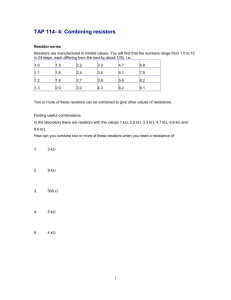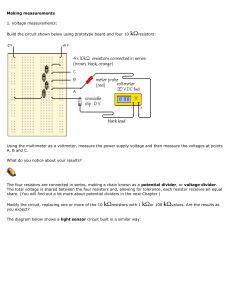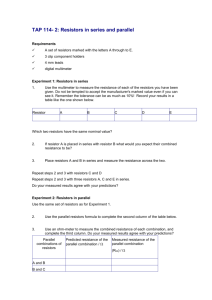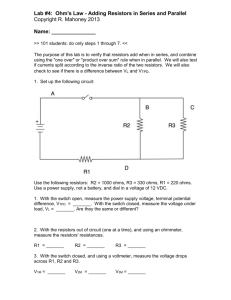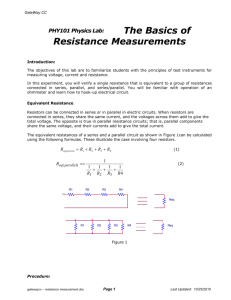Series Resistance Lab Report: Ohm's Law & Kirchhoff's Law
advertisement
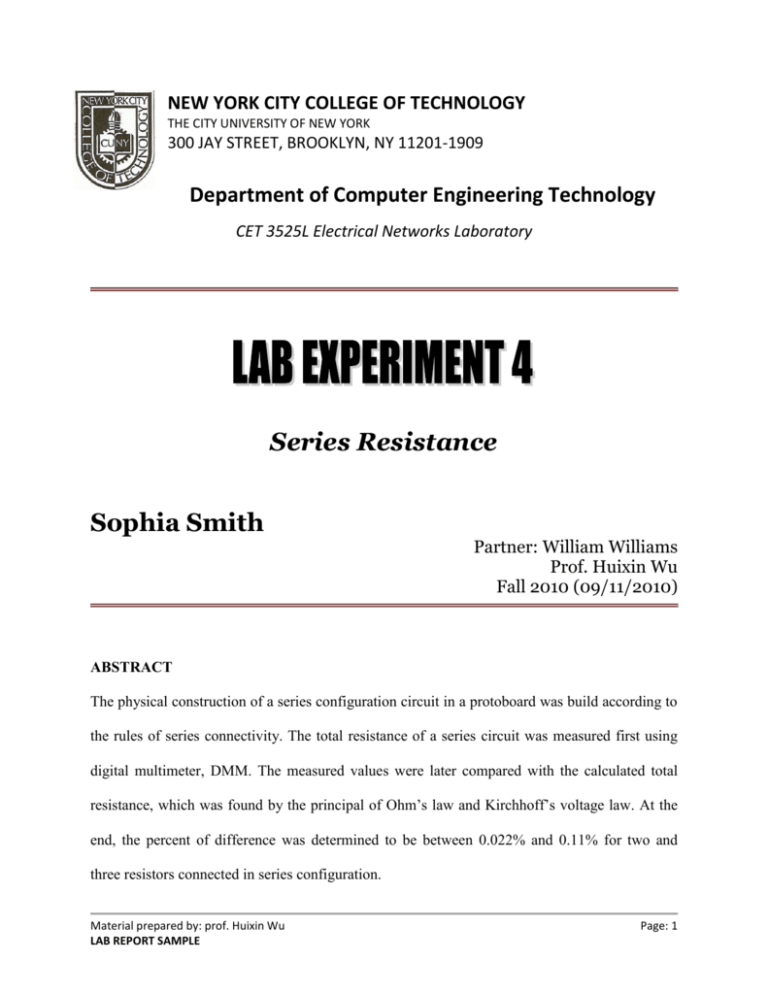
NEW YORK CITY COLLEGE OF TECHNOLOGY THE CITY UNIVERSITY OF NEW YORK 300 JAY STREET, BROOKLYN, NY 11201-1909 Department of Computer Engineering Technology CET 3525L Electrical Networks Laboratory Series Resistance Sophia Smith Partner: William Williams Prof. Huixin Wu Fall 2010 (09/11/2010) ABSTRACT The physical construction of a series configuration circuit in a protoboard was build according to the rules of series connectivity. The total resistance of a series circuit was measured first using digital multimeter, DMM. The measured values were later compared with the calculated total resistance, which was found by the principal of Ohm’s law and Kirchhoff’s voltage law. At the end, the percent of difference was determined to be between 0.022% and 0.11% for two and three resistors connected in series configuration. Material prepared by: prof. Huixin Wu LAB REPORT SAMPLE Page: 1 I. INTRODUCTION According to circuit topology, two or more elements are connected in series if they exclusively share a single node and consequently carry the same current. Due to it, an equivalent resistance of resistors connected in series is found by the fundamental circuit laws, Ohm’s law and Kirchhoff’s law. As it is stated in Ohm’s law, where the current through the conductor between points is directly proportional to the potential difference across the two points: I = V/R (1) and Kirchhoff’s voltage law, KVL, where the sum of all voltages is zero volts, then is found that the equivalent resistance of any number of resistors connected in series is the sum of the individual resistance: Req = R1 + R2 + R3 + … RN (2) where N is the total number of resistors connected in series configuration. In this experiment, we determine, by measurements and calculations, the equivalent resistance of different resistors connected in series. The percent of difference between the measured and calculated, using equation 1 and 2, is also states with the following: (3) II. EXPERIMENT Post to our lab experiment, we calculated the total resistance for part 1, two resistors in series, and part 2, three resistors in series, using equation 2. Calculated results were recorded in Table 4.1. For the first part of the experiment, two series resistors, we took a 220 Ω and 100 Ω resistor and a protoboard from our lab components kit. We measured the value of each resistor, using a Material prepared by: prof. Huixin Wu LAB REPORT SAMPLE Page: 2 digital multimeter, and recorded our measurements in our lab manual. Later, we connected both resistors in series configuration in our protoboard, and connected one terminal of the 220 Ω and one terminal of the 100 Ω with the positive and negative lead of the digital multimeter, respectively. We measured the total resistance and recorded our measurement in Table 4.1. After it, we obtained the leads for the power supply from the lab technician. We set the power supply to 8 V, and connected the positive lead with one terminal of the 220 Ω resistor, and the negative lead with the other terminal of the 100 Ω resistor. After it, we set our digital multimeter to measure the current, so we swapped the positive lead of the multimeter to current input, and set it to measure milli-amperes. We then connected the positive lead of the multimeter in series with the circuit, the positive lead of the multimeter to the positive terminal of the power supply, and the negative lead of the multimeter to one terminal of the 220 Ω resistor. We measured the current as 25.1 mA. On a sheet of paper, we calculated the total resistance using Ohm’s law, equation 1, and the percent of difference, using equation 3, between the measured total resistance, 318.8 Ω, and the calculated total resistance using equation 1, 319 Ω, and equation 2, 318.7 Ω. All calculations were recorded in Table 4.1 For the second part of our experiment, we obtained a 330 Ω from our components kit, measured the resistance value as 325 Ω, and connected it in series with our previous series circuit. We then measured the total resistance using a digital multimeter and recorded our measurements in Table 4.2. After it, we connected the power supply, set to 8 volts, and the ammeter in series with the three resistors connected in series. All measurements were recorded in Table 4.2. On a sheet of paper, we calculated the total resistance using equation 2, and the percent of difference between the measured total resistance, 644.7 Ω, and the calculated total Material prepared by: prof. Huixin Wu LAB REPORT SAMPLE Page: 3 resistance using equation 1, 644 Ω, and equation 2, 645.2 Ω. All calculations were recorded in Table 4.2. III. RESULTS AND DISCUSSION For part 1, two series resistors configuration circuit, 100 Ω and 220 Ω resistors, was built to find the total resistance. The total resistance was found by calculation, using equation 1 and 2, and measurement, using a digital multimeter. Table 4.1 presents the total resistance of two resistors connected in series and the percent of difference between the measured and calculated value. Rearranging from equation 1, indicates that the total resistance of a series configuration circuit is directly proportional to the voltage source and inversely proportional to the current source. According to it, the calculated total resistance is found to be 318.7 Ω. Also, from equation 2, the total resistance of a series configuration circuit is the sum of the individual resistance connected in series, giving a calculated value of 319 Ω. In connection to it, the percent of difference between each calculated value and measured value is found to be 0.022 %, for total resistance calculated using equation 1, and 0.063%, for total resistance calculated using equation 2. For part 2, Table 4.2 gives the total resistance of three series resistors connected in series configuration, 100 Ω, 220 Ω, and 330 Ω resistors, and the percent of difference between the measured and calculated value. The total resistance is found using equation 1, 645.2 Ω, equation 2, 644 Ω, and by measurement, 644.7 Ω, using a digital multimeter. At the end, the percent of difference between each calculated value and measured value is found to be 0.07 %, for total resistance calculated using equation 1, and 0.11%, for total resistance calculated using equation 2. Material prepared by: prof. Huixin Wu LAB REPORT SAMPLE Page: 4 Table 4.1 – Total resistance of two resistors connected in series and % difference between the measured and calculated value: Total resistance value found my measurement using digital multimeter, and by calculation using equation 1 and 2; % difference found using equation (3) RT (calculated) RT (ohmmeter) % difference I (measured) RT (Ohm’s law) % difference 319 Ω 318.9 Ω 0.063 % 25.1 mA 318.7 Ω 0.022 % Table 4.2 – Total resistance of three resistors connected in series and % difference: Total resistance value found my measurement using digital multimeter, and by calculation using equation 1 and 2; % difference found using equation (3) RT (calculated) RT (ohmmeter) % difference I (measured) RT (Ohm’s law) % difference 644 Ω 644.7 Ω 0.11 % 12.4 mA 645.2 Ω 0.07 % CALCULATION Part 1: two series resistors R1(measured) = 218 Ω R2(measured) = 101 Ω RT = R1 + R2 = 218 Ω + 101 Ω RT = 319 Ω Part 2: Three series resistors R1(measured) = 101 Ω R2(measured) = 218 Ω R3(measured) = 325 Ω RT = R1 + R2 + R3 = 101 Ω + 218 Ω + 325 Ω RT = 644 Ω Material prepared by: prof. Huixin Wu LAB REPORT SAMPLE Page: 5 QUESTIONS 1. For a circuit with a constant resistance, what happens to the current as the voltage increases? If there is a constant resistance in the circuit, the current is directly proportional to the voltage and will increase as the voltage increases. 2. For a circuit with a constant resistance, what kind of relationship (e.g., inverse,linear) does the current have to the voltage? For a circuit with a constant resistance, current will have a directly proportional and hence linear relationship with voltage. This can be proven by looking at Ohm’s law V=I×R and also by looking at the graphs of this experiment. IV. CONCLUSION We can conclude from our results in part 1 and 2 that the total resistance is directly proportional to the voltage source and inversely proportional to current source, equation 1. Also, in a series resistors circuit, since all resistors share the same current flow, and by applying the principles of Kirchhoff’s law, the total resistance of resistors connected in series is the sum of its individual resistance, equation 2. At the end, the percent of difference between the calculated Material prepared by: prof. Huixin Wu LAB REPORT SAMPLE Page: 6 value and measured value is found to be between 0.022% and 0.11%. This indicates that the founding of the total resistance by experiment is almost equal to the calculated value, using different approach theories of resistance in series resistors configuration. Material prepared by: prof. Huixin Wu LAB REPORT SAMPLE Page: 7 Material prepared by: prof. Huixin Wu LAB REPORT SAMPLE Page: 8 Material prepared by: prof. Huixin Wu LAB REPORT SAMPLE Page: 9 Material prepared by: prof. Huixin Wu LAB REPORT SAMPLE Page: 10 Material prepared by: prof. Huixin Wu LAB REPORT SAMPLE Page: 11 Material prepared by: prof. Huixin Wu LAB REPORT SAMPLE Page: 12


